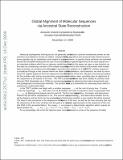Global Alignment of Molecular Sequences via Ancestral State Reconstruction
Author(s)
Andoni, Alexandr; Daskalakis, Constantinos; Hassidim, Avinatan; Roch, Sebastien
DownloadDaskalakis-Global Alignment.pdf (201.5Kb)
OPEN_ACCESS_POLICY
Open Access Policy
Creative Commons Attribution-Noncommercial-Share Alike
Terms of use
Metadata
Show full item recordAbstract
Molecular phylogenetic techniques do not generally account for such common evolutionary events as site insertions and deletions (known as indels). Instead tree building algorithms and ancestral state inference procedures typically rely on substitution-only models of sequence evolution. In practice these methods are extended beyond this simplified setting with the use of heuristics that produce global alignments of the input sequences—an important problem which has no rigorous model-based solution. In this paper we open a new direction on this topic by considering a version of the multiple sequence alignment in the context of stochastic indel models. More precisely, we introduce the following trace reconstruction problem on a tree (TRPT): a binary sequence is broadcast through a tree channel where we allow substitutions, deletions, and insertions; we seek to reconstruct the original sequence from the sequences received at the leaves of the tree. We give a recursive procedure for this problem with strong reconstruction guarantees at low mutation rates, providing also an alignment of the sequences at the leaves of the tree. The TRPT problem without indels has been studied in previous work (Mossel 2004, Daskalakis et al. 2006) as a bootstrapping step towards obtaining information-theoretically optimal phylogenetic reconstruction methods. The present work sets up a framework for extending these works to evolutionary models with indels. In the TRPT problem we begin with a random sequence x[subscript 1], . . . , x[subscript k] at the root of a d-ary tree. If vertex v has the sequence y[subscript 1], . . . y[subscript kv] , then each one of its d children will have a sequence which is generated from y[subscript 1], . . . y[subscript kv] by flipping three biased coins for each bit. The first coin has probability p[subscript s] for Heads, and determines whether this bit will be substituted or not. The second coin has probability p[subscript d], and determines whether this bit will be deleted, and the third coin has probability pi and determines whether a new random bit will be inserted. The input to the procedure is the sequences of the n leaves of the tree, as well as the tree structure (but not the sequences of the inner vertices) and the goal is to reconstruct an approximation to the sequence of the root (the DNA of the ancestral father). For every χ > 0 we present an algorithm which outputs with probability 1−χ an approximation of x[subscript 1], . . . , x[subscript k] if p[subscript i] + p[subscript d] < O(1/k[subscript 2/3] log n) and (1 − 2p[subscript s])[superscript 2] > Cd[superscript −1] log d for some constant C > 0, and every large enough d. To our knowledge, this is the first rigorous trace reconstruction result on a tree in the presence of indels.
Date issued
2010Department
Massachusetts Institute of Technology. Department of Electrical Engineering and Computer ScienceJournal
Proceedings of the Innovations in Computer Science 2010
Publisher
Institute for Theoretical Computer Science (ITCS)
Citation
Alexandr Andoni et al. "Global Alignment of Molecular Sequences via Ancestral State Reconstruction" Proceedings of the Innovations in Computer Science 2010, ITCS.
Version: Author's final manuscript